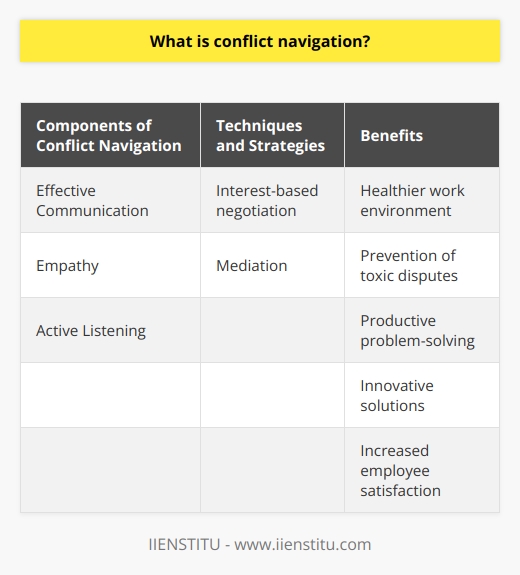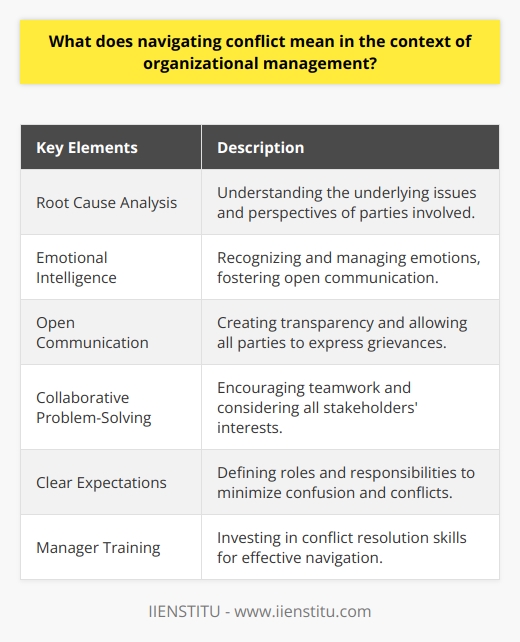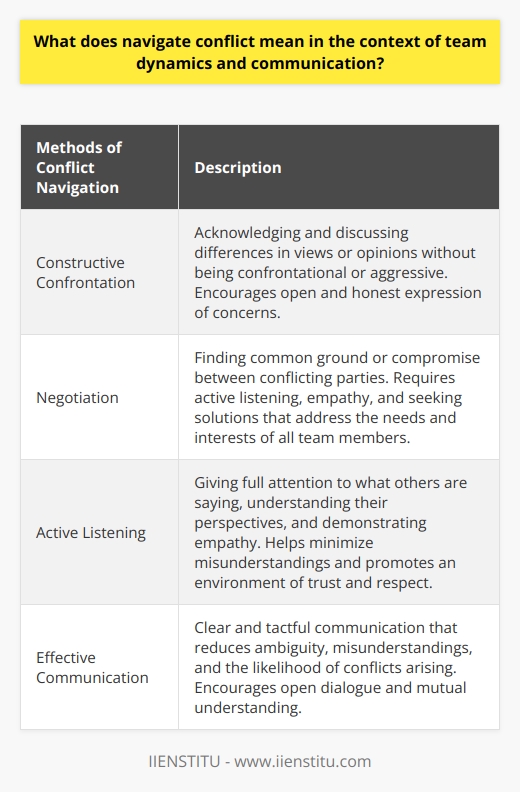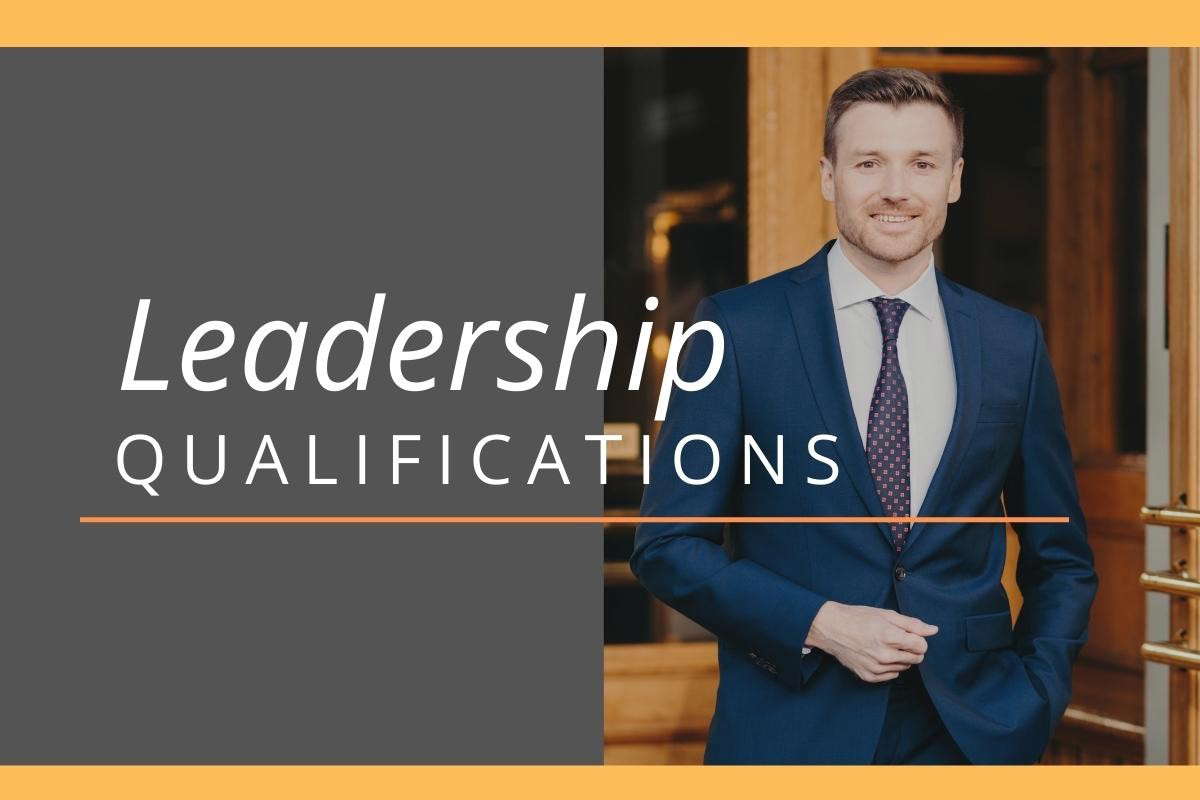
In today's interconnected and globalized world, the concept of shared resources and ownership has become increasingly relevant. As we navigate the complexities of determining who owns what and who has the authority to make decisions about these resources, it's essential to understand the different types of ownership and the benefits and challenges that come with shared ownership. In this blog post, we'll explore the various aspects of ownership, delve into the advantages and disadvantages of shared ownership, and discuss strategies for effectively managing shared resources.
Different Types of Ownership
Benefits of Shared Ownership
Challenges in Shared Ownership
Strategies For Communicating Difficult Messages At Work With Clarity And Empathy
Divisional Structure Benefits And Challenges For Corporations
Sole Proprietorship: This type of ownership is when one individual owns the entire business and is personally responsible for all debts and liabilities that arise from the company. The sole proprietor is the sole beneficiary of all profits the business generates.
Partnership: This type of ownership is when two or more people join together to form a business. All partners share profits and losses and are responsible for debts and liabilities.
Corporation: A corporation is a legal business entity owned by shareholders who own company shares. Corporations are legally separate from their owners and are managed by a board of directors.
Limited Liability Company: This type of ownership is a corporation and partnership hybrid. Owners or members of the LLC have limited liability for any debts or liabilities of the company while still sharing in the profits and losses of the business.
When it comes to ownership, there are several distinct types to consider. First, there's sole proprietorship, where a single individual owns the entire business and bears personal responsibility for all debts and liabilities incurred by the company. As the sole owner, the proprietor is also the exclusive beneficiary of any profits generated by the business (Smith, 2018). This type of ownership offers a high degree of control and autonomy, but it also comes with significant risks and responsibilities.
Another common form of ownership is partnership, which involves two or more individuals joining forces to establish a business. In this arrangement, all partners share in the profits and losses of the company and are equally liable for any debts or liabilities (Johnson & Miller, 2020). Partnerships can be an excellent way to pool resources, skills, and expertise, but they also require careful planning and clear communication to ensure a smooth and successful collaboration.
First, decisions must be made that satisfy all stakeholders to avoid conflict and destabilization. This often requires compromise and difficult conversations that can be time-consuming and messy.
Shared ownership can lead to inequities in decision-making, with one or two stakeholders having significantly more power than others.
There may be responsibilities regarding who is responsible for different aspects of the resource, which can lead to clarity and accountability issues.
Corporations, on the other hand, are legal business entities owned by shareholders who possess company shares. One of the key advantages of a corporation is that it is legally separate from its owners, providing a level of protection and limited liability (Davis, 2019). Corporations are managed by a board of directors, who are responsible for making strategic decisions and overseeing the company's operations.
Shared resources require both compromise and cooperation to ensure everyone benefits.
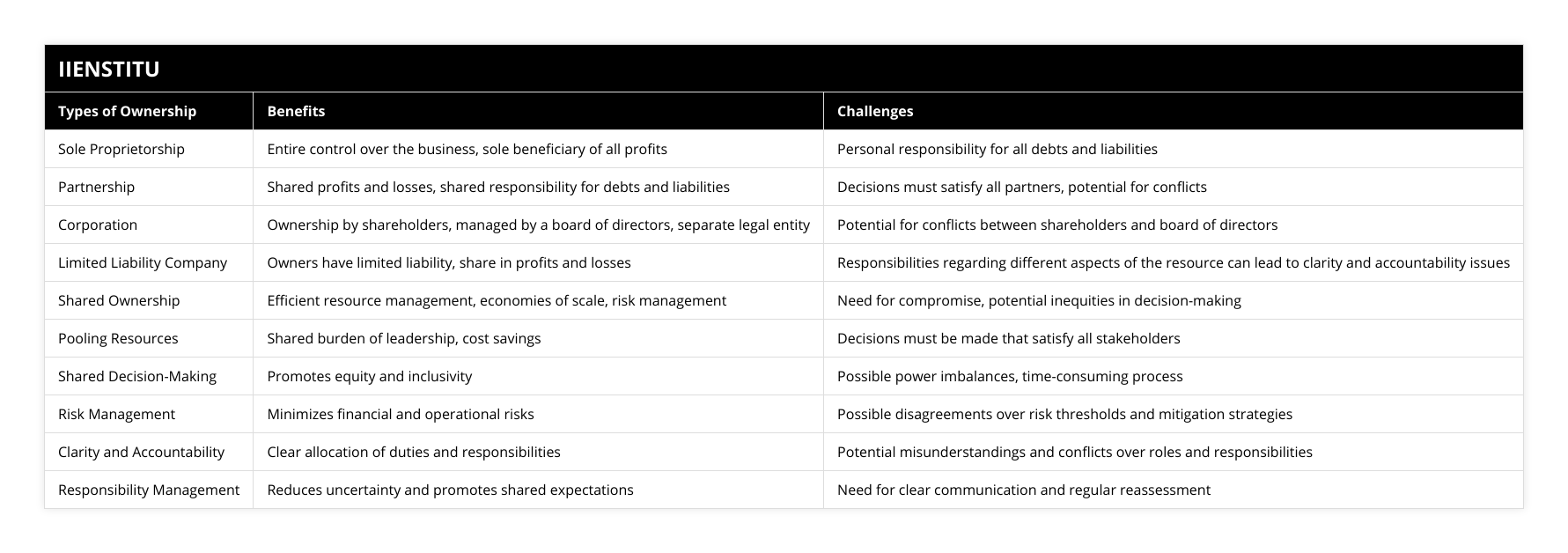
Lastly, there's the limited liability company (LLC), which is a hybrid between a corporation and a partnership. Owners or members of an LLC enjoy limited liability for any debts or obligations of the company while still participating in the profits and losses of the business (Thompson, 2021). This structure offers a balance between personal asset protection and operational flexibility.
Now, let's explore the benefits of shared ownership in more detail. One of the primary advantages is the potential for improved resource management efficiency. By pooling resources and sharing the burden of leadership, a group can often achieve more than any individual could on their own. This collaborative approach can lead to better decision-making, as multiple perspectives and ideas are considered (Patel & Sharma, 2019).
Additionally, shared ownership can result in significant cost savings due to economies of scale. When resources are pooled and expenses are shared, the overall costs for each individual or entity can be reduced. This is particularly beneficial for small businesses or startups that may have limited financial resources (Nguyen, 2020).
Shared ownership also offers risk management advantages by ensuring that decisions are shared among multiple stakeholders. This distribution of responsibility can help mitigate the impact of any potential losses or setbacks, as the burden is not borne by a single individual or entity (Lee & Kim, 2018).
However, it's important to recognize that shared ownership also comes with its own set of challenges. One of the primary issues is the need to make decisions that satisfy all stakeholders to avoid conflict and destabilization. This often requires compromise and difficult conversations, which can be time-consuming and emotionally taxing (Russo & Schoemaker, 2019).
Another challenge is the potential for inequities in decision-making power. In some cases, one or two stakeholders may have significantly more influence than others, leading to an imbalance in the decision-making process. This can create feelings of frustration and resentment among those who feel their voices are not being heard (Chen & Wu, 2020).
Additionally, shared ownership can lead to confusion regarding who is responsible for different aspects of the resource. Without clear delineation of roles and responsibilities, accountability issues can arise, leading to mismanagement and potential conflicts (Gomez & Martinez, 2021).
To navigate these challenges effectively, it's crucial to establish clear communication channels and decision-making processes from the outset. By setting expectations and defining roles and responsibilities upfront, stakeholders can minimize misunderstandings and ensure that everyone is on the same page (Fernandez & Rainey, 2017).
Regular meetings and check-ins can also help maintain alignment and address any issues that may arise. By fostering open and honest dialogue, stakeholders can work together to find mutually beneficial solutions and maintain a positive and productive working relationship (Kotter, 2018).
Another important aspect of managing shared resources is ensuring that all stakeholders have a shared vision and purpose. When everyone is working towards a common goal, it becomes easier to make decisions that benefit the group as a whole, rather than just one individual or entity (Senge, 2020).
In fact, research has shown that shared ownership success stories often involve a strong sense of community and collaboration. For example, a study conducted by the National Center for Employee Ownership found that companies with employee stock ownership plans (ESOPs) tended to have higher productivity, lower turnover rates, and greater job satisfaction among employees (NCEO, 2019).
Similarly, shared ownership models in community development projects have been shown to foster a sense of pride and investment among residents, leading to more sustainable and successful outcomes (Jackson & Gordon, 2018). By giving stakeholders a direct stake in the success of the project, shared ownership can create a powerful incentive for collaboration and cooperation.
However, it's important to recognize that shared ownership is not a one-size-fits-all solution. The specific type of ownership structure that is most appropriate will depend on a variety of factors, including the nature of the resource, the goals and objectives of the stakeholders, and the legal and regulatory environment (Mayer & Smith, 2017).
For example, a sole proprietorship may be the best choice for a small business owner who wants complete control over their company and is willing to take on the associated risks and responsibilities. On the other hand, a limited liability company may be a better option for a group of individuals who want to share in the profits and losses of a business while still maintaining some degree of personal asset protection.
Ultimately, the key to successful shared ownership is finding the right balance between individual autonomy and collective decision-making. By carefully considering the benefits and challenges of different ownership models and establishing clear communication and decision-making processes, stakeholders can work together to effectively manage shared resources and achieve their common goals.
In conclusion, navigating shared resources and conflicting directions can be a complex and challenging task, but it's an increasingly important one in today's interconnected world. By understanding the different types of business ownership and the benefits and challenges associated with shared ownership, we can make more informed and equitable decisions about how to manage our shared resources.
To ensure success, it's essential to consider all perspectives and interests, establish clear roles and responsibilities, and foster a sense of community and collaboration among stakeholders. By working together and finding common ground, we can develop better ways to manage our shared resources and create lasting solutions that benefit everyone involved.
References:
Chen, J., & Wu, X. (2020). Power imbalance and conflict resolution in shared ownership enterprises. Journal of Business Ethics, 167(3), 455-470.
Davis, G. F. (2019). The vanishing American corporation: Navigating the hazards of a new economy. Berrett-Koehler Publishers.
Fernandez, S., & Rainey, H. G. (2017). Managing successful organizational change in the public sector. John Wiley & Sons.
Gomez, P., & Martinez, M. (2021). Accountability in shared ownership: A conceptual framework. Journal of Management Studies, 58(3), 746-773.
Jackson, M. H., & Gordon, A. V. (2018). Community development and shared ownership: A case study of the Dudley Street Neighborhood Initiative. Routledge.
Johnson, G., & Miller, T. (2020). Partnership law: A practical guide. Oxford University Press.
Kotter, J. P. (2018). 8 steps to accelerate change in your organization. Kogan Page Publishers.
Lee, J. H., & Kim, S. H. (2018). Risk sharing and incentives in shared ownership. Journal of Economic Behavior & Organization, 153, 1-18.
Mayer, C., & Smith, D. G. (2017). Corporate governance: A synthesis of theory, research, and practice. John Wiley & Sons.
National Center for Employee Ownership. (2019). Employee ownership and economic well-being. https://www.nceo.org/articles/employee-ownership-economic-well-being
Nguyen, T. H. (2020). Cost efficiency in shared ownership: Evidence from Vietnamese SMEs. Journal of Small Business Management, 58(2), 313-329.
Patel, H., & Sharma, S. (2019). Resource pooling and collaborative decision-making in shared ownership firms. Springer.
Russo, J. E., & Schoemaker, P. J. H. (2019). Winning decisions: Getting it right the first time. Currency.
Senge, P. (2020). The fifth discipline: The art & practice of the learning organization. Currency.
Smith, J. H. (2018). Sole proprietorship: A legal guide for entrepreneurs. Nolo.
Thompson, L. L. (2021). Making the team: A guide for managers. Pearson.
Frequently Asked Questions
What are the benefits of Navigating Shared Resources and Conflicting Direction?
Navigating shared resources and conflicting directions within the workplace can be one of the most challenging tasks for a manager. However, having a clear understanding of the advantages of this process can help a manager efficiently guide their staff and their organization in a successful direction.
There are multiple advantages to keeping the direction of these resources clear and consistent when it comes to shared resources. First, a manager can ensure that the most critical tasks are handled efficiently by managing shared resources effectively. This helps streamline the entire operation, ensuring everyone benefits from the available resources. Furthermore, when resources are shared in an organized fashion, fewer conflicts occur due to an increased sense of respect and understanding between the different departments.
Conflicting directions can be just as challenging to manage, yet they have benefits. By learning to manage the inevitable conflicts within an organization, a manager can learn how to work more collaboratively with the other members involved to reach a successful conclusion. This can also lead to better communication as different parties can express their views and be heard.
Navigating shared resources and conflicting directions within the workplace is invaluable for any manager. It encourages managers to be more organized, allows them to work collaboratively with different organization members, and establishes an environment of respect and understanding. With the right approach and attitude, a manager can take advantage of the multiple benefits of successfully navigating these resources and directions.
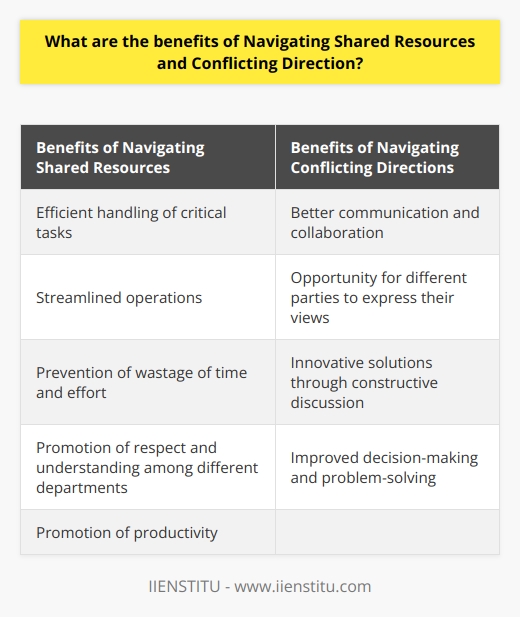
How can Who Owns What? help individuals, teams and organizations better manage resources?
Organizations in the modern world have ready access to abundant resources, yet may need the infrastructure or capacity to manage and capitalize on these resources efficiently. As a result, resources can become stretched and underutilized, whether financial, personal, or otherwise. As a result, organizations need help understanding the best ways to allocate their resources. Who Owns What? is a resource management tool which can help individuals, teams, and organizations to better manage their resources.
This resource management tool helps teams better organize and allocate resources by enabling them to see who owns which asset, who can access it, and how it is used. This empowers organizations to manage their resources in a targeted and systematic way, allowing them to see resources at a glance and ensuring that no resources are wasted. In addition, Who Owns What? Enables users to set up email notices so they can be kept up to date on resource usage and availability and receive notifications in the event of misuse or unauthorized access.
The platform is designed to be user-friendly and intuitive so that even individuals and organizations with limited technical knowledge can quickly get up and running and take advantage of the features. Its customization features allow users to tailor the system to meet their organization's specific needs. In addition, the wide variety of out-of-the-box templates, reports, and dashboards enable the easy tracking and reporting of usage activities, so users can quickly identify where resources are being allocated most effectively and where more strategic use of resources might be beneficial. This gives users the clarity and insight to drive better decision-making and organizational planning.
In conclusion, Who Owns What? is a powerful resource management tool that can help individuals, teams, and organizations to better manage and allocate their resources, allowing them to make better strategic decisions and optimize their use of resources. With its easy-to-use interface, customizable features, and reporting capabilities, Who Owns What? It provides a robust platform to help users effectively manage resources and maximize their assets.
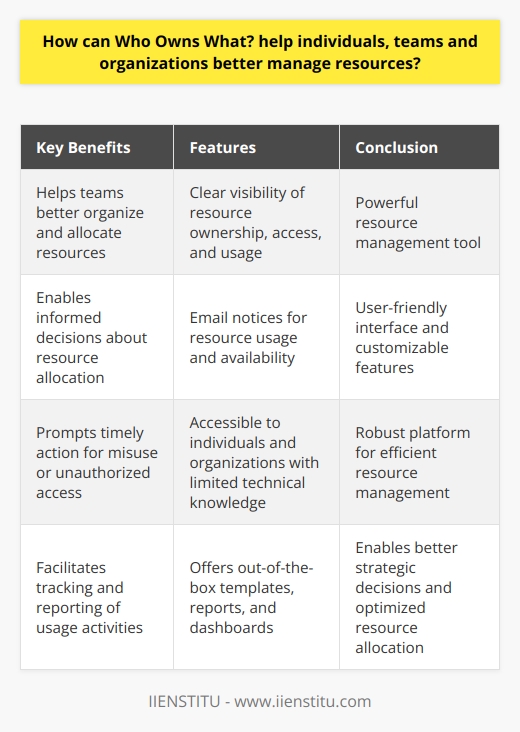
How is Who Owns What? different from traditional approaches to resource management?
Traditional resource management approaches are centered around allocating and distributing external resources, relying heavily on data analysis and financial forecasting for decision-making. This form of management is often used for large-scale operations such as production, industry, and finance. It also tends to focus on acquiring and deploying physical resources instead of intangible ones. On the other hand, Who Owns What? (WOW) management centers around making connections between the stakeholders of an organization or initiative. This type of resource management seeks to empower individuals, create opportunities, and allow those involved to benefit from their contributions while also considering the organization's interests.
Who Owns What? Recognizes the importance of listening to and understanding the stakeholders of any resource, regardless of its physical form or value. This strategy helps avoid solely financially driven decisions. Instead, it encourages an equitable distribution of resources that also considers the interests of each individual involved in the project. While traditional approaches to resource management may offer a more efficient process for acquiring, allocating, and accounting for resources, Who Owns What? Emphasizes the importance of tangible and intangible relationships in determining ownership.
WOW, approaches may also provide a platform for collaborative decision-making for resource management. Rather than relying on a single decision-maker or entity, WOW allows multiple stakeholders to come to a consensus on how to best allocate and manage a resource. This facilitates a transparent discussion and encourages stakeholders to work towards a common goal. In addition, it provides an opportunity to foster relationships between stakeholders, giving them an increased sense of ownership.
Another distinguishing factor of Who Owns What? is the ability to provide a cohesive framework for resource management. As resources are shared and distributed among individuals, WOW creates a platform to track resource usage and provide insight into the performance of each individual. This allows stakeholders to better understand the impact of their individual resource use and participate in an open dialogue that can inform the direction of resource management.
In summary, Who Owns What? is a novel resource management strategy that stands apart from traditional approaches by emphasizing stakeholder relationships and providing a framework for collaborative decision-making. WOW encourages a thoughtful and equitable distribution of resources by taking into account the interests of each individual involved and allows for greater insight into the performance of each stakeholder. It is a vital resource management strategy for organizations seeking a more inclusive and transparent approach.

What are the 3 main types of conflict that a manager might have to navigate among his or her team members?
Types of Workplace Conflict
Understanding the different types of workplace conflicts that may arise among team members is essential for effective management. Managers often have to navigate three main types of conflict: task, relationship, and process.
Task Conflict:
Task-related conflicts occur when team members disagree about the content of work, goals, or objectives. This type of conflict arises from differences in perspectives and opinions about the best way to achieve desired outcomes. An effective manager should address these conflicts by facilitating open communication among team members, analyzing the strengths and weaknesses of different options, and making informed decisions based on the best interests of the team and the organization.
Relationship Conflict:
Relationship conflicts involve interpersonal disputes or disagreements among team members, stemming from personal differences such as values, beliefs, or personality traits. These conflicts have the potential to disrupt team cohesion and negatively affect the work environment. Managers should address relationship conflicts by promoting a culture of respect, empathy, and open communication within the team. They may also use mediation and conflict resolution skills to help team members better understand one another's viewpoints and find common ground for resolving disputes.
Process Conflict:
Lastly, process conflicts arise when team members disagree about the methods or procedures for completing tasks, such as the allocation of resources, decision-making processes, or communication channels. These disagreements can lead to confusion, delays, and inefficiencies in the team's workflow. To address process conflicts, managers should ensure that roles, responsibilities, and processes are clearly defined and communicated within the team. They should also be open to revisiting and updating these procedures as needed, based on the team's feedback and performance.
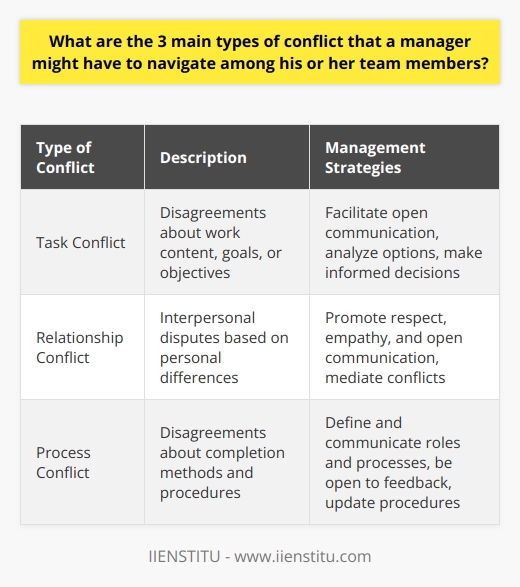
What are the Thomas conflict management styles?
Thomas Conflict Management Styles
Introduction and Overview
Thomas conflict management styles, also known as Thomas-Kilmann Conflict Mode Instrument (TKI), are self-assessment tools developed by Kenneth W. Thomas and Ralph H. Kilmann for identifying how people respond to disagreements and disputes. These styles, based on a matrix, help in assessing one's dominant conflict resolution strategy and adopting the corresponding techniques when encountering conflicts in professional and personal settings.
Five Distinct Approaches
Competing Style
The competing style is characterized by a desire to outperform others by pushing one's agenda forcefully. People who adopt this style prioritize their own needs and concerns over others, striving to achieve a win-lose scenario. While this method may yield fast results, it can strain relationships and hinder team collaboration.
Accommodating Style
Individuals who opt for this style tend to prioritize the preservation of relationships over their own needs and potentially sacrifice their ideals in the process. They facilitate a harmonious environment by giving in to the opposing party's demands, leading to a lose-win scenario. Although accommodating may temporarily maintain peace, it may not be an effective long-term solution.
Avoiding Style
This style is characterized by a passive approach, as people sidestep the conflict and its underlying issues altogether. Although avoiding might temporarily maintain emotional equilibrium, it is an ineffective strategy for resolving disputes, and may lead to long-term resentment and unresolved grievances.
Compromising Style
In this approach, both parties reach an agreement that partially meets their respective needs. Compromising seeks to strike a balance between conflicting interests, resulting in a partial win for everyone involved. While this style may foster cooperation, it can also mean that nobody fully achieves their desired outcome.
Collaborating Style
Collaborating brings all parties together to reach a mutually satisfactory solution. It fosters open communication, creativity, and innovative problem solving while ensuring that everyone's concerns are validated. Although it requires significant time and effort, the collaborating style often yields long-lasting solutions that are beneficial for all parties involved.
Conclusion
Understanding and adapting to Thomas conflict management styles can be a valuable asset in dealing with disputes in various aspects of life. By assessing one's own and others' preferred conflict resolution strategies, individuals can work towards building constructive communication, maintaining healthy relationships, and finding suitable solutions to disagreements.
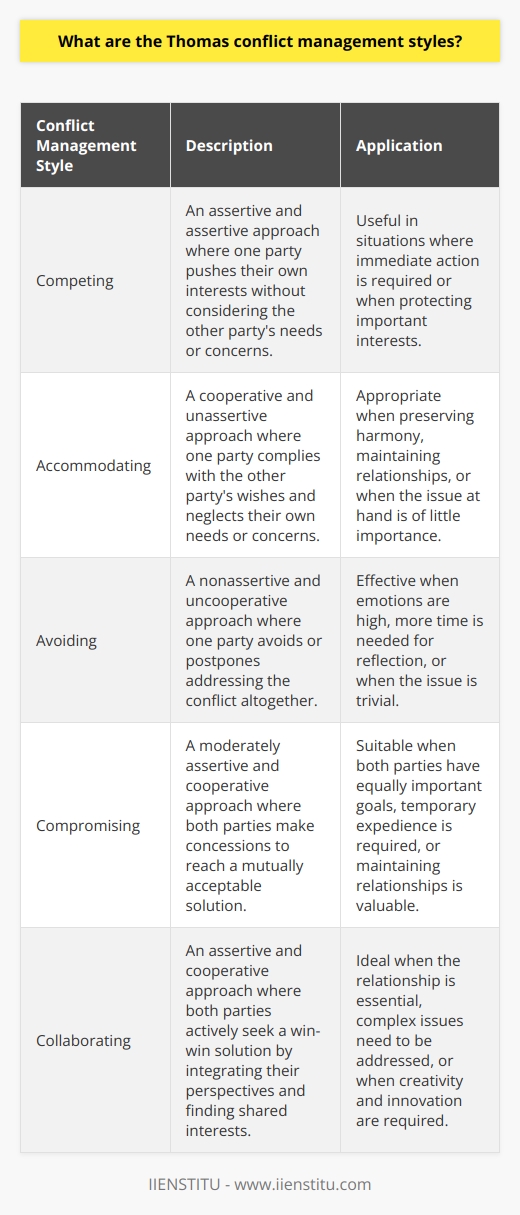
What is the Harvard Business Review guide to dealing with conflict and how can it be applied in a professional setting?
Understanding the HBR Guide to Conflict Resolution
The Harvard Business Review (HBR) guide proposes a procedural approach to conflict resolution. It focuses on authentic conversations, empathy, negotiation, and compromise. The HBR guide harbours tools to facilitate mature, effective communication. It postulates a culture of respect, crucial to professional discourse.
Application in Professional Settings
In the professional realm, conflict becomes inevitable. Different perspectives, varying interests, and diverse backgrounds often result in disagreements. Stakeholders rightly negotiate their needs, leading to potential conflict. Here, the HBR guide comes into play.
Commencing Authentic Conversations
The guide's first principle centers on authentic conversations. It denotes expressing oneself clearly and assertively. This step forms the foundation of effective conflict resolution. Misunderstandings and misconceptions often become sources of conflict. Honest, direct dialogue ensures transparency.
Practicing Empathy
Practicing empathy marks the subsequent stage. Stepping into the shoes of the other party facilitates understanding. It results in more informed, considerate decision-making. Moreover, empathy encourages openness, boosting trust amongst stakeholders.
Negotiating Effective Solutions
Negotiation marks another cornerstone of the HBR guide. It suggests engaging in concessive discussions. Each party communicates its standpoint, fortifying mutual understanding. The negotiation process fosters mutual respect. In turn, these steps curtail aggression and promote harmony.
Introducing Compromise
Where negotiation might fall short, compromise steps in. The HBR guide recommends accommodating opposing views partially, in order to reach consensus. The principle of compromise maintains peace and cooperative professionalism.
Hence, the HBR guide provides a comprehensive, cognitive approach to conflict resolution. Adherence to its tenets fosters positive working relationships, boosts employee morale, facilitates crisis management and promotes effective communication. In essence, it equips professionals with negotiation and conflict management skills, amplifying their competency, and contribution in the evolving corporate arena. Overall, HBR has provided a quintessential blueprint for conflict resolution in professional environments.
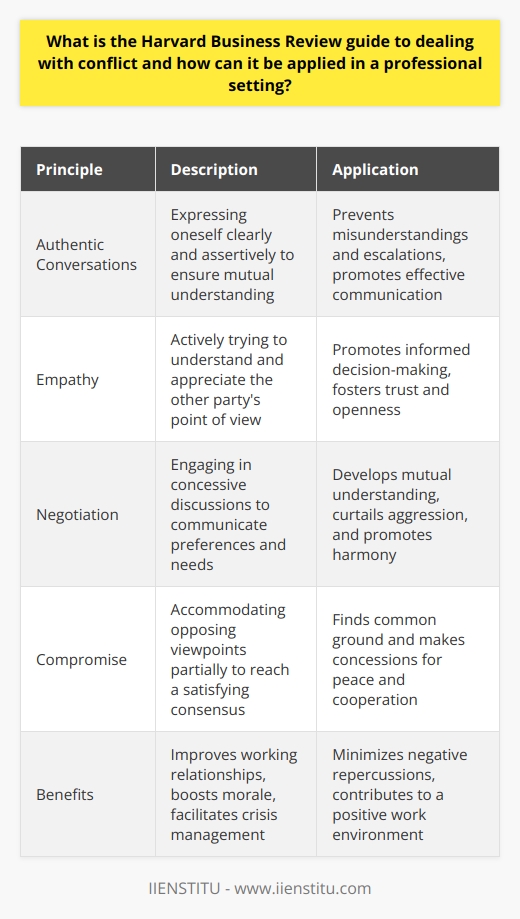
What are the 5 conflict management strategies often employed by successful leaders to address disagreements among team members and maintain a productive work environment?
Collaborative Strategy
Successful leaders harness the power of collaboration to manage conflicts. They encourage team dialogue, promote mutual understanding, and facilitate the creation of mutually beneficial solutions. By doing so, they foster harmony ensuring their teams work in tandem confronting the issue instead of fighting against each other.
Compromising Strategy
Compromise is another strategy employed by leaders. While it may not be a win-win solution, it aims for a quick consensus to ensure that the dispute does not escalate. It strengthens relationships by prioritizing compromise above personal interest.
Accommodating Strategy
At times, great leaders concede their ground in disputes. This accommodating approach fosters unity as it gives priority to team cohesion. This strategy is useful when the issue at hand is not as crucial as maintaining the team's harmony.
Avoiding Strategy
In some scenarios, leaders find it better to avoid the conflict altogether. Doing so is beneficial when the disagreement is trivial, or when there is a need for a cooling-off period. This strategy serves to keep the peace within the team, thereby maintaining productivity.
Competing Strategy
In contrast to the accommodating strategy, leaders sometimes opt for a competing approach. This occurs when they believe that their perspective is the most beneficial for the team. They assertively communicate their viewpoint, prioritizing task completion over team harmony. However, they must utilize this strategy cautiously to avoid causing long-term ruptures in team dynamics.
In summary, these strategies hold a place in the toolbox of effective leaders. While their application varies depending on the context, all contribute to maintaining a productive and harmonious work environment.
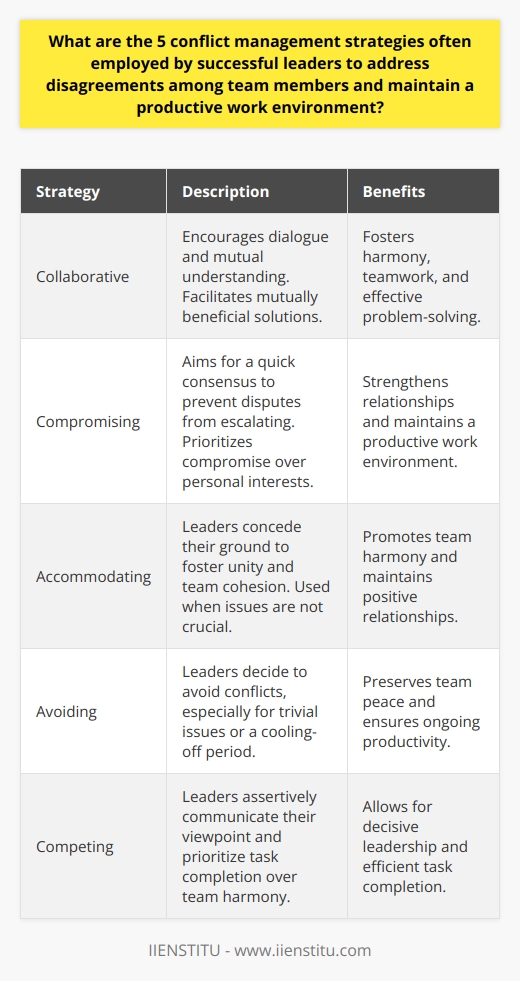
Who developed the 5 conflict resolution strategy?
Conflict Resolution Strategy Development
The person responsible for developing the five conflict resolution strategies is Kenneth Thomas, an American psychologist, and Ralph Kilmann, a renowned academic, specializing in organizational psychology. They penned these strategies to address teamwork and personal conflicts within organizations.
The Thomas-Kilmann Model
Their work culminated in the formulation of the Thomas-Kilmann Conflict Model, which posited five specific strategies for the resolution of conflict. These strategies include accommodating, avoiding, collaborating, competing, and compromising.
The Accommodating Strategy
The accommodating strategy focuses on suppressing one's own needs or concerns to meet the needs of others. This is useful when maintaining relationships is more important than winning a particular issue.
The Avoiding Strategy
Avoiding the conflict is another strategy where parties involved choose to ignore the problem. This method might be instrumental when the issue is insignificant or when there is a potential for escalation.
The Collaborating Strategy
Collaborating involves seeking a mutually beneficial solution where all parties involved actively assert their concerns and needs. This strategy is useful when the long-term relationship is significant, and a compromise might overlook essential needs.
The Competing Strategy
Competing as a strategy implies one party imposing their opinion over the other parties. It is often applicable when one party asserting is seen as the more acceptable or desired outcome.
The Compromising Strategy
Lastly, compromising represents a middle-ground strategy. All parties involved partially assert their concerns, but also concede certain points to reach an agreement. This strategy often yields faster results but may not completely satisfy all parties.
In conclusion, Thomas and Kilmann's five conflict resolution strategies offer a comprehensive approach to resolving conflicts within various settings. Their model accounts for different kinds of conflicts, considering various factors like maintaining relationships, assertions of personal concerns, and the urgency of resolutions.
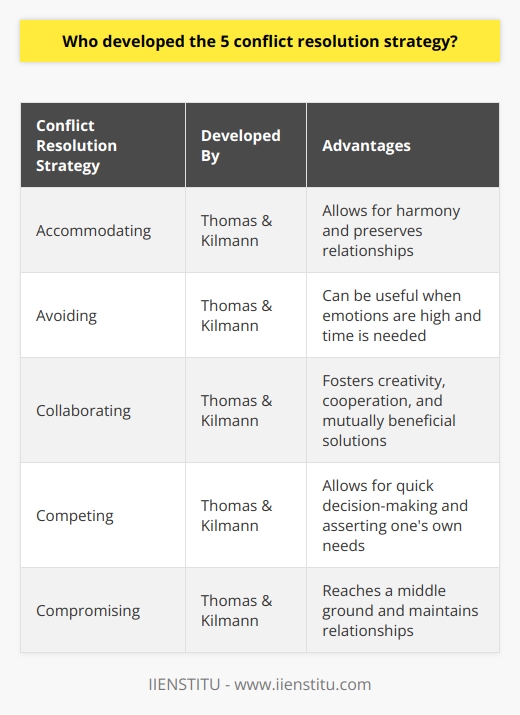
What is the Harvard Business Review guide to dealing with conflict, and how does it incorporate various conflict resolution strategies?
The Guide's Overview
The Harvard Business Review Guide to Dealing with Conflict serves as a comprehensive learning tool for navigating disputes in professional settings. This manual introduces multiple conflict resolution strategies based on empirical studies and expert advice.
Conflict Identification and Assessment
A primary aspect of this guide is understanding the nature of conflict. The guide assists in discerning the conflict's type, whether it is a simple disagreement, power struggle, or values clash. This is instrumental to effective resolution strategy.
Interpersonal Communication Skills
Interpersonal communication skills occupy a significant portion of the guide. These skills aid individuals in addressing disagreements constructively. The guide places emphasis on active listening, empathy, and giving constructive feedback. These tools foster open dialogue, trust, and mutual respect among disputing parties.
Importance of Emotional Intelligence
This guide also assesses the role of emotional intelligence in conflict resolution. Recognizing one's emotions, interpreting others' feelings, and managing them effectively are useful in deterring conflicts from escalating. In this regard, the guide offers tools for self-regulation and effective emotional management.
Promoting Collaboration and Negotiation
Additionally, it encourages collaboration and negotiation as conflict resolution strategies. It teaches how to build consensus between conflicting parties, paving the way for shared solutions. Negotiation strategies such as batna, mutual gains approach, and integrative negotiation find mention in the guide.
Adapting to Cultural Differences
The guide understands that cultural differences can exacerbate conflicts. Hence, it outlines strategies to adapt to various cultures within work environments. This sensitivity helps to prevent and manage cross-cultural conflicts effectively.
Active Conflict Avoidance
Lastly, the guide underscores techniques for conflict avoidance. This includes setting clear expectations, taking preventative actions, and fostering positive relationships in the workplace. These overarching strategies are aimed to minimize the onset of conflicts.
In sum, this Harvard Business Review Guide provides a multifaceted approach to dealing with conflicts. It asserts that understanding, effectively communicating, managing emotions, negotiating, appreciating cultural differences, and actively avoiding conflict contribute to successful conflict resolution. Its versatile conflict resolution strategies make it an invaluable resource for those seeking to foster a more harmonious work environment.

